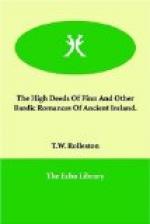This addition of life, or of some of the powers of life, to tree and well and boulder-stone, to river and lake and hill, and sword and spear, is common to all mythologies, but the special character of each nation or tribe modifies the form of the life-imputing stories. In Ireland the tree, the stream were not dwelt in by a separate living being, as in Grecian story; the half-living powers they had were given to them from without, by the gods, the demons, the fairies; and in the case of the weapons, the powers they had of act or sound arose from the impassioned thoughts and fierce emotions of their forger or their wielder, which, being intense, were magically transferred to them. The Celtic nature is too fond of reality, too impatient of illusion, to believe in an actual living spirit in inanimate things. At least, that is the case in the stories of the Hero and the Fenian Cycles.[5]
[5] Everything, on the contrary, in the Mythological Cycle is gifted with life, all the doings and things of nature are represented as the work of living creatures; but it is quite possible that those in Ireland who made these myths were not Celts at all.
What the Irish of the Heroic, and still more of the Fenian Cycle, did make in their imagination was a world, outside of themselves, of living spiritual beings, in whose actuality they fully believed, and in whom a great number of them still believe. A nation, if I may use this term, dwelt under the sea. Another dwelt in the far island of the ocean, the Isle of the Ever-Young. Another dwelt in the land, in the green hills and by the streams of Ireland; and these were the ancient gods who had now lost their dominion over the country, but lived on, with all their courtiers and warriors and beautiful women in a country underground. As time went on, their powers were dwarfed, and they became small of size, less beautiful, and in our modern times are less inclined to enter into the lives of men and women. But the Irish peasant still sees them flitting by his path in the evening light, or dancing on the meadow round the grassy mound, singing and playing strange melodies; or mourns for the child they have carried away to live with them and forget her people, or watches with fear his dreaming daughter who has been touched by them, and is never again quite a child of this earth, or quite of the common race of man.
These were the invisible lands and peoples of the Irish imagination; and they live in and out of many of the stories. Cuchulain is lured into a fairy-land, and lives for more than a year in love with Fand, Mananan’s wife. Into another fairy-land, through zones of mist, Cormac, as is told here, was lured by Mananan, who now has left the sea to play on the land. Oisin, as I have already said, flies with Niam over the sea to the island of Eternal Youth. Etain, out of the immortal land, is born into an Irish girl and reclaimed and carried back to her native shore by Midir, a prince of the Fairy Host. Ethne, whose story also is here, has lived for all her youth in the court of Angus, deep in the hill beside the rushing of the Boyne.




